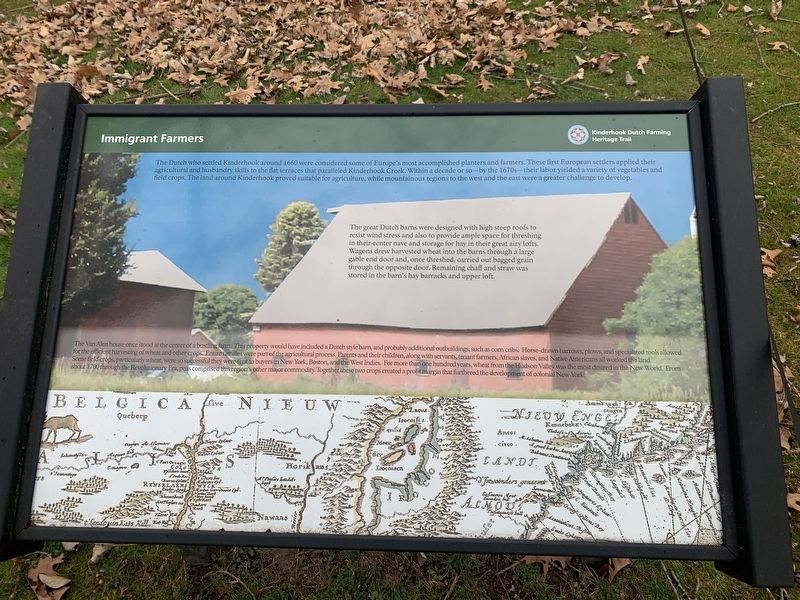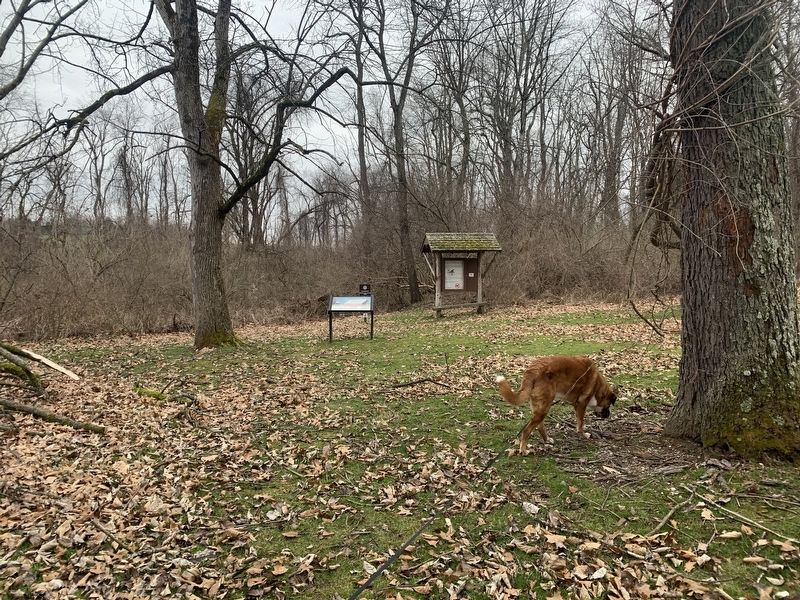Near Kinderhook in Columbia County, New York — The American Northeast (Mid-Atlantic)
Immigrant Farmers
Kinderhook Dutch Farming Heritage Trail
The Dutch who settled Kinderhook around 1660 were considered some of Europe's most accomplished planters and farmers. These first European settlers applied their agricultural and husbandry skills to the flat terraces that paralleled Kinderhook Creek. Within a decade or so by the 1670s - their labor yielded a variety of vegetables and field crops. The land around Kinderhook proved suitable for agriculture, while mountainous regions to the west and the cast were a greater challenge to develop.
The great Dutch barns were designed with high steep roofs to resist wind stress and also to provide ample space for threshing in their center nave and storage for hay in their great airy lofts. Wagons drew harvested wheat into the barns through a large gable end door and, once threshed, carried out bagged grain through the opposite door. Remaining chaff and straw was stored in the barn's hay barracks and upper loft.
The Van Alen house once stood at the center of a bustling farm. This property would have included a Dutch style barn, and probably additional outbuildings, such as corn cribs. Horse-drawn furrows, plows, and specialized tools allowed for the efficient harvesting of wheat and other crops. Entire families were part of the agricultural process. Parents and their children, along with servants, tenant farmers, African slaves, and Native Americans all worked the land. Some field corps, particularly wheat, were so successful they were to buyers in New York, Boston, and the West Indies. For more than one hundred years, wheat from the Hudson Valley was the most desired in the New World. From about 1700 through the Revolutionary Era, peas comprised this region’s other major commodity. Together these two crops created a profit margin that furthered the development of colonial New York.
Erected by Columbia County Historical Society.
Topics. This historical marker is listed in these topic lists: Agriculture • Colonial Era • Immigration • Industry & Commerce. A significant historical year for this entry is 1660.
Location. 42° 22.874′ N, 73° 41.553′ W. Marker is near Kinderhook, New York, in Columbia County. Marker can be reached from New York State Route 9H, 0.2 miles north of Fischer Road, on the right when traveling south. Marker can be reached on foot from the Ichabod Crane Schoolhouse parking lot. Touch for map. Marker is at or near this postal address: 2589 NY-9H, Kinderhook NY 12106, United States of America. Touch for directions.
Other nearby markers. At least 8 other markers are within walking distance of this marker. Native Inhabitants (within shouting distance of this marker); Black Locust Trees (within shouting distance of this marker); Enslavement In The Hudson Valley (within shouting distance of this marker); Washington Irving (within shouting distance of this marker); Colonial Dutch Houses (1690-1750) (about 400 feet away, measured in a direct line); Early Dutch Settlers (about 400 feet away); Eleanor Roosevelt at Ichabod Crane (about 500 feet away); One-Room Schoolhouses (about 600 feet away). Touch for a list and map of all markers in Kinderhook.
Credits. This page was last revised on April 18, 2024. It was originally submitted on April 11, 2024, by Steve Stoessel of Niskayuna, New York. This page has been viewed 53 times since then. Photos: 1, 2. submitted on April 11, 2024, by Steve Stoessel of Niskayuna, New York. • Michael Herrick was the editor who published this page.

